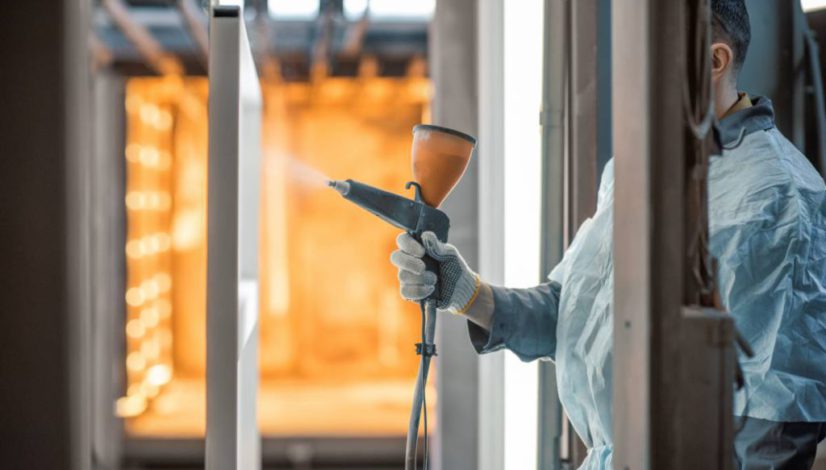What is Powder Coating, How Does it Work, and Why is it a Good Choice?
To understand why a powder coating coat is a good choice, it is important to first understand the application process. Powder coating consists of an electrostatic application of organic powder to metal parts that require coating for protection or decoration. The powder is cured by fire, resulting in a continuous hard coating process. This process includes a pre-treatment, an application of powder, and exposure to high temperatures.
The process begins with the pre-treatment, that is, the preparation of the surface of the substrate. Each part is cleaned, removing grease, dirt, and anything else that might interfere with the coating. Such preparation includes abrasive, mechanical, or chemical cleaning. This depends on where the metal surface to be treated is cleaned so that it adheres well with the powder during the subsequent curing process. Without proper pre-treatment, dust on certain parts will easily chip and corrode, hence its importance.
In addition, the best results are obtained when rust or pre-existing coatings are removed. After this phase, the object must be completely dry before applying the powder. This can be accomplished using air drying methods or hanging items on shelves. An oven is even used for this drying process, although the objects must be cooled before the powder is applied. Regarding the level of freshness, this varies according to the thickness of the desired coating.
Once the part is completely dry, it is ready for powder coating using a fluidized bed or spray technique. The powder becomes electrically charged as it is applied to the part, giving each particle a negative charge. The part to be coated is electrically grounded as a means of attracting and bonding the charged powder to the surface of the part. This electrostatic attraction is a key requirement of the process, as it helps the uniformity of the coating and the speed of its application. The result is an even layer of dry powder that adheres to the object. After the part is powder coated, it is moved to a curing oven, where the powdered gels flow and cure, producing a smooth product and durable finish. A chemical crosslinking reaction occurs in the curing process between the powder particles. At this point, the piece can be removed from the kiln, cooled to room temperature, and prepared for release to market.
The advantages of powder or powder coating coat are many and generally fall under four categories:
- Performance. Powder coatings are durable and resistant to corrosion, chemicals, and weather. Additionally, powder-coated surfaces are more resistant to chipping, scratching, and other wear caused by the heat bonding process during curing. Powders also do not run or drip, providing a more uniform coating.
- Operating Costs. Powder coatings are cheaper and can cover a greater area than most organic finishes. This translates to lower costs than other paint processes. Because they lend themselves well to automation, powder coatings can also reduce costs associated with operational labor, thanks to minimal operator training and supervision. Cost savings with powder coatings include less waste produced, lower energy costs, lower disposal costs, and less rework.
- Security. Some other coatings are flammable, carcinogenic, and contain volatile organic compounds (VOCs). Such chemicals can be hazardous to personnel if not handled properly. At the same time, powder coatings are generally VOC and solvent-free, meaning they do not involve potentially harmful chemicals typically found in conventional methods. Although powder coating materials can burn in a very small concentration of dust and air, their lack of solvents or VOCs poses no health risks or short- and long-term fire threats.
- Environment. Volatile organic compounds (VOCs) in some painting processes are also among the industrial pollution problems. Because powder coatings are solvent-free, they are more environmentally friendly. In addition, powder coating is a clean process as the excess powder can be recovered and reused in a hopper for recirculation through the system, with negligible waste. It should be added that most powder coating materials are considered non-hazardous materials, so they can be safely disposed of.
Choosing a supplier for Powder Coating
Obviously, on the market, there is a wide variety of suppliers that offer all kinds of paints, from industrial to those for domestic use. However, the importance lies in carrying out an analysis of the subject and making a good choice. In this sense, there are some considerations before selecting a paint supplier, such as price, quality, and brands. Below are issues to consider when seeking to choose the best option:
Price quality
Considering that the price is one of the elements most analyzed by customers when making a purchase, it is necessary to know the value for money. Precisely for this, there are economic, medium, or premium options. In such a way, the customers seeking powder coating services must verify the specifications of the used paints and know the certifications.
Portfolio
Finding a powder coating supplier with the required tonalities, presentations, contrasts, functionalities, and qualities is a priority. This is precisely because if the potential service provider has the necessary variety in its portfolio, it will position itself as that ideal solution for its customers. As mentioned at the beginning, the market is full of brands used in powder coating.
Service
Last but not least, service is one of the fundamentally important issues in choosing a company to provide powder coating services. Additionally, experience is also important in choosing a supplier. Nothing can substitute a solid business relationship in which a supplier offers its potential customer the ability to negotiate, to see product samples for evaluation, and to receive advice and training if required.
If you are interested to discuss your coating projects with our coating specialists please use the contact form and we will be happy to speak with you.

